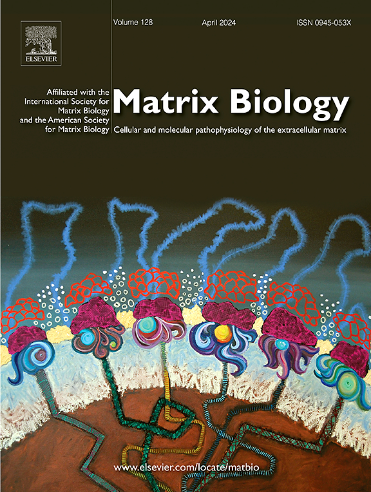OSCC-derived EVs educate fibroblasts and remodel collagen landscape
IF 4.5
1区 生物学
Q1 BIOCHEMISTRY & MOLECULAR BIOLOGY
引用次数: 0
Abstract
Cancer-associated myofibroblasts (mCAFs) represent a significant component of the tumor microenvironment due to their contributions to extracellular matrix (ECM) remodeling. The pro-tumor mechanisms of extracellular vesicles (EVs) by regulating mCAFs and related collagens remain poorly understood in oral squamous cell carcinoma (OSCC). In this study, through analysis of single-cell sequencing data and immunofluorescence staining, we confirmed the increased presence of mCAFs and enrichment of specific collagen types in OSCC tissues. Furthermore, we demonstrated that OSCC-derived EVs promote the transformation of fibroblasts into mCAFs, leading to tumor invasion. Proteomic analysis identified the presence of TGF-β1 in EVs and revealed its role in inducing mCAFs via the TGF-β1/SMAD signaling pathway. Experiments in vivo confirmed that EVs, particularly those carrying TGF-β1, trigger COL18high COL5high matrix deposition, thereby forming the pro-tumor ECM in OSCC. In summary, our investigation unveils the significant involvement of OSCC-derived EVs in orchestrating the differentiation of fibroblasts into mCAFs and modulating specific collagen types within the ECM. Therefore, this study provides a theoretical basis for targeting the EV-mediated TGF-β1 signaling pathway as a potential therapeutic strategy for OSCC.
OSCC 衍生的 EV 可教育成纤维细胞并重塑胶原景观。
癌症相关肌成纤维细胞(mCAFs)是肿瘤微环境的重要组成部分,因为它们有助于细胞外基质(ECM)的重塑。在口腔鳞状细胞癌(OSCC)中,人们对细胞外囊泡(EVs)通过调节 mCAFs 和相关胶原来促进肿瘤生长的机制仍然知之甚少。在本研究中,通过分析单细胞测序数据和免疫荧光染色,我们证实了在 OSCC 组织中 mCAFs 的存在增加和特定胶原类型的富集。此外,我们还证明 OSCC 衍生的 EVs 促进成纤维细胞转化为 mCAFs,从而导致肿瘤侵袭。蛋白质组学分析发现,EVs 中存在 TGF-β1,并揭示了其通过 TGF-β1/Smad3 信号通路诱导 mCAFs 的作用。体内实验证实,EVs(尤其是携带 TGF-β1 的 EVs)可诱导 COL18high COL5high 基质沉积,从而形成 OSCC 中的促肿瘤 ECM。总之,我们的研究揭示了 OSCC 衍生的 EVs 在协调成纤维细胞分化为 mCAFs 和调节 ECM 中特定胶原类型方面的重要参与。因此,本研究为靶向 EV 介导的 TGF-β1 信号通路作为 OSCC 的潜在治疗策略提供了理论依据。
本文章由计算机程序翻译,如有差异,请以英文原文为准。
求助全文
约1分钟内获得全文
求助全文
来源期刊

Matrix Biology
生物-生化与分子生物学
CiteScore
11.40
自引率
4.30%
发文量
77
审稿时长
45 days
期刊介绍:
Matrix Biology (established in 1980 as Collagen and Related Research) is a cutting-edge journal that is devoted to publishing the latest results in matrix biology research. We welcome articles that reside at the nexus of understanding the cellular and molecular pathophysiology of the extracellular matrix. Matrix Biology focusses on solving elusive questions, opening new avenues of thought and discovery, and challenging longstanding biological paradigms.
 求助内容:
求助内容: 应助结果提醒方式:
应助结果提醒方式:


